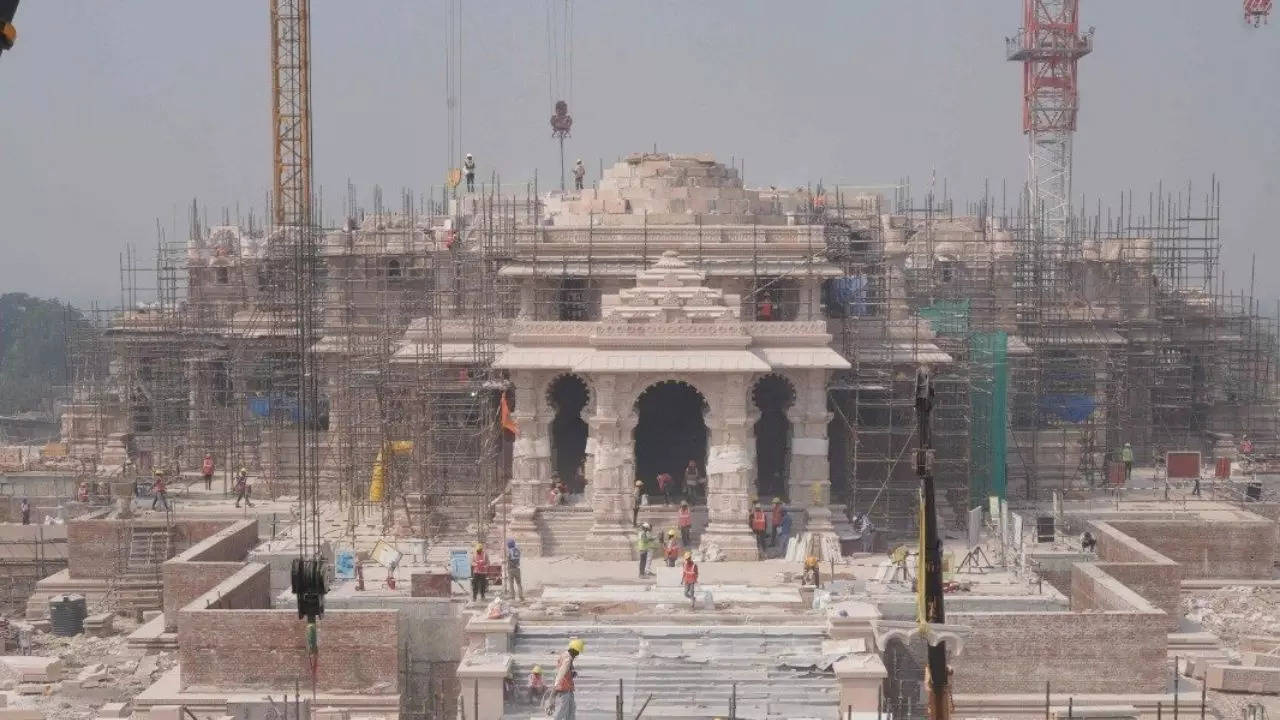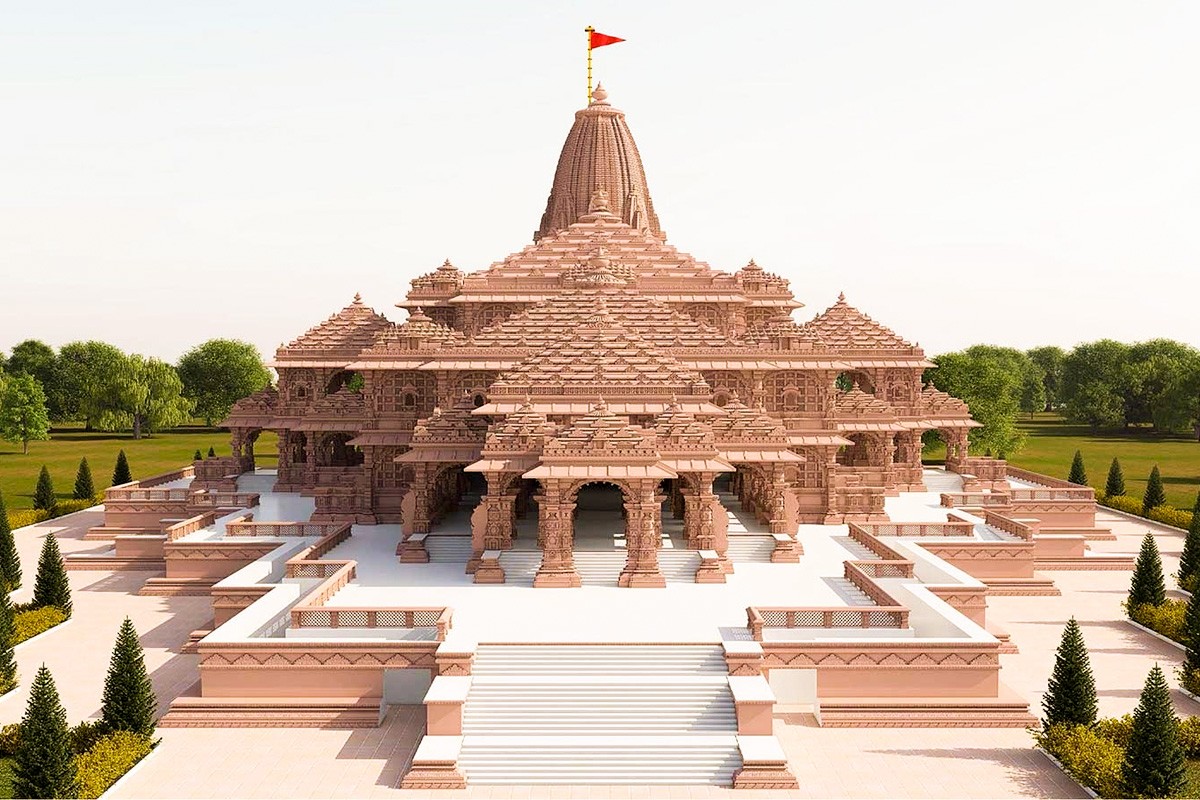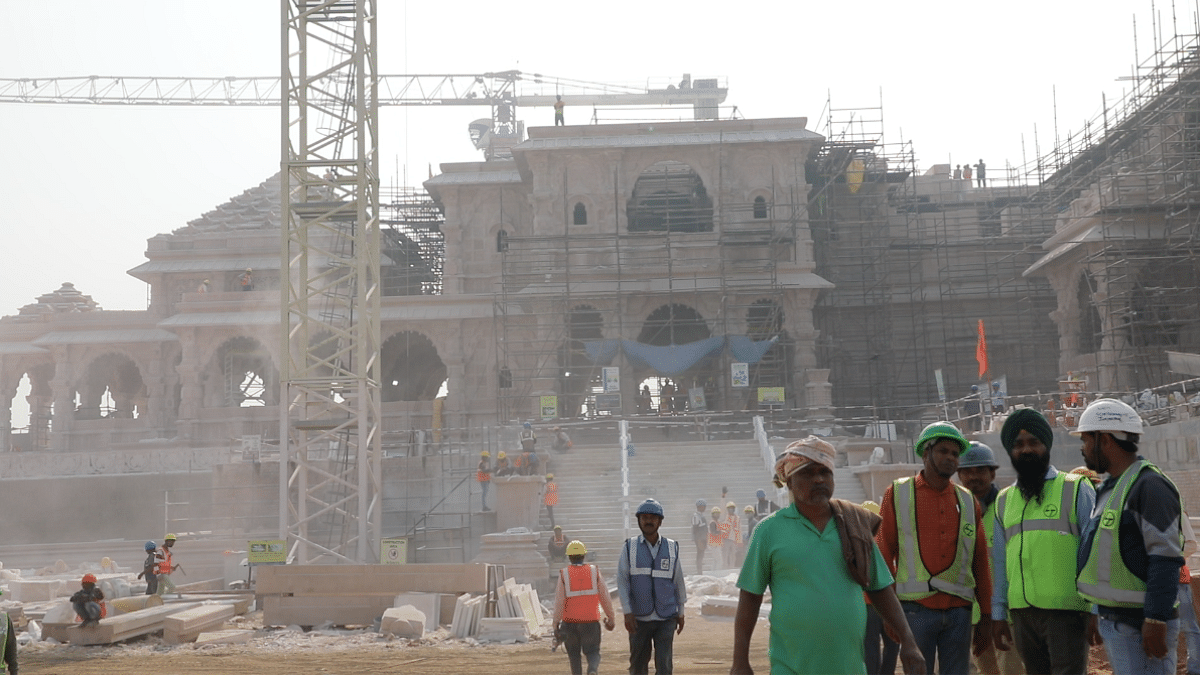The history of the Ayodhya Ram Mandir is deeply rooted in the religious and cultural landscape of India. The site is associated with the Hindu epic, the Ramayana, and has been a source of contention and dispute for several decades. The construction of the Ram Mandir in Ayodhya holds immense significance for Hindus, and its history is marked by both religious beliefs and legal battles.
HISTORY Of Ayodhya Ram Mandir
Contents
- 1 HISTORY Of Ayodhya Ram Mandir
- 2 What is the story behind Ram Mandir?
- 3 What is Ayodhya story?
- 4 Why was Sri Rama’s capital named Ayodhya?
- 5 Who has made Ram Mandir?
- 6 where is ayodhya?
- 7 Geographical Location:
- 8 What is the old name of Ayodhya? write in detailed or simple english
- 9 Who fought Ram Mandir case?

Ancient History:
Ayodhya Ram Mandir is considered one of the oldest cities in India and is believed to be the birthplace of Lord Rama, a revered figure in Hinduism. According to the Ramayana, Lord Rama was born in Ayodhya, and the city served as his capital during his reign.
Mughal Period:
The Babri Masjid, a mosque, was constructed in Ayodhya in the 16th century during the Mughal era. It is believed to have been built by Mir Baqi, a general in the army of the Mughal emperor Babur, in 1528.
British Era:
In the 19th century, tensions began to rise over the site as Hindu and Muslim communities claimed ownership. The British administration erected a fence to maintain peace and separate the inner and outer courtyards of the disputed area.
Post-Independence Period:
After gaining independence in 1947, India witnessed increased religious tensions. The dispute over the Ayodhya Ram Mandir site became a prominent issue, with both Hindu and Muslim communities staking claim to it.
Babri Masjid Demolition (1992):
The turning point in the Ayodhya dispute occurred on December 6, 1992, when a large mob of Hindu activists demolished the Babri Masjid, claiming that it was built on the birthplace of Lord Rama. This event led to nationwide communal riots and significant political repercussions.
Legal Battles:
The demolition of the Babri Masjid led to numerous legal battles over the ownership of the site. Various cases were filed in Indian courts to determine the rightful owner of the land.
Ayodhya Verdict (2019):
In November 2019, the Supreme Court of India delivered a historic verdict in the Ayodhya Ram Mandir case. The court ruled that the disputed land should be handed over to a trust for the construction of the Ram Mandir, while an alternative five-acre plot was allocated for the construction of a mosque.
Construction of Ram Mandir:
Following the court’s decision, the construction of the Ram Mandir began in Ayodhya Ram Mandir. The temple is designed to be an architectural marvel, reflecting traditional Indian temple architecture and accommodating the beliefs and sentiments of millions of Hindus.

What is the story behind Ram Mandir?

The story behind the Ayodhya Ram Mandir is deeply rooted in Hindu mythology, primarily recounted in the ancient Indian epic, the Ramayana. The Ram Mandir, dedicated to Lord Rama, is believed to be constructed at the site where Rama, the seventh avatar of Lord Vishnu, was born. The narrative of the Ram Mandir can be summarized as follows:
Birth of Lord Rama:
According to the Ramayana, Lord Rama was born in Ayodhya Ram Mandir to King Dasharatha and Queen Kaushalya. Rama, along with his three brothers—Lakshmana, Bharata, and Shatrughna—is an exemplary figure in Hinduism, known for his adherence to dharma (righteousness).
Exile of Lord Rama:
Rama’s stepmother, Kaikeyi, manipulated King Dasharatha to fulfill her two boons, resulting in Rama’s exile to the forest for 14 years. Rama’s wife, Sita, and his loyal brother Lakshmana accompanied him during this period.(Ayodhya Ram Mandir)
Abduction of Sita:
While in exile, Sita was abducted by the demon king Ravana, who took her to Lanka. Rama, aided by the monkey-god Hanuman and an army of monkeys, waged a war against Ravana to rescue Sita.
Construction of Ram Setu:
Rama, with the help of his army, built a bridge (known as Ram Setu or Adam’s Bridge) from the southern tip of India to Lanka. This bridge enabled Rama’s army to cross the sea and reach Lanka for the final battle against Ravana.
Victory of Good over Evil:
The battle between Rama and Ravana concluded with Rama’s victory, symbolizing the triumph of good over evil. Rama, along with Sita and Lakshmana, returned to Ayodhya after completing the 14-year exile.(Ayodhya Ram Mandir)
Return to Ayodhya and Coronation:
Rama’s return to Ayodhya is celebrated as Diwali, the festival of lights. His return marks the end of his exile, and he was welcomed by the people of Ayodhya. Rama was eventually crowned as the king of Ayodhya.
Belief in Birthplace in Ayodhya:
The belief that Ayodhya is the birthplace of Lord Rama is deeply ingrained in Hindu tradition. The spot where Rama is believed to have been born is considered sacred by Hindus.
Construction of the Ram Mandir:
The construction of the Ram Mandir in Ayodhya is seen as the fulfillment of a longstanding desire among Hindus to build a grand temple dedicated to Lord Rama at his believed birthplace.
The story of the Ram Mandir is not only a religious narrative but also a cultural and historical legacy for millions of Hindus. The construction of the temple in Ayodhya is a momentous event, representing the culmination of decades of religious and legal struggles.
Ayodhya, also known as Saket, is an ancient city in the northern Indian state of Uttar Pradesh. The story of Ayodhya is deeply intertwined with Hindu mythology, particularly the epic Ramayana. Here is an overview of the Ayodhya story:
Historical and Mythological Significance:
Ayodhya is considered one of the oldest cities in the world and holds immense historical and mythological significance. It is mentioned in ancient Hindu scriptures, including the Vedas.
Birthplace of Lord Rama:
The most prominent aspect of Ayodhya’s story is its association with the birth of Lord Rama, one of the principal deities in Hinduism. According to the Ramayana, Ayodhya was the capital of the Kosala Kingdom, and King Dasharatha ruled from there. Rama, the seventh avatar of Lord Vishnu, was born to King Dasharatha and Queen Kaushalya in Ayodhya.
Life and Rule of Lord Rama:
Ayodhya is described as a prosperous and well-administered city during the rule of King Dasharatha and, later, during the brief reign of Lord Rama. Rama, known for his adherence to dharma (righteousness), ruled Ayodhya with justice and fairness.
Exile and Return of Lord Rama:
The story takes a turn when Queen Kaikeyi, influenced by a maid named Manthara, seeks two boons from King Dasharatha. As a result, Rama is sent into exile for 14 years. After successfully completing his exile and defeating the demon king Ravana, Rama returns to Ayodhya, where he is welcomed with grand celebrations.
Diwali Festival:
The return of Lord Rama to Ayodhya is celebrated as Diwali, the festival of lights. The people of Ayodhya illuminated the city with lamps to welcome their beloved king. Diwali remains one of the most widely celebrated festivals in India.
Babri Masjid and Ayodhya Dispute:
In the later part of history, Ayodhya became the center of a dispute between Hindus and Muslims regarding the Babri Masjid, which was believed by some Hindus to have been built on the site where Lord Rama was born. This led to years of legal battles and, ultimately, the demolition of the mosque in 1992.
Ayodhya Verdict and Ram Mandir:
In 2019, the Supreme Court of India delivered a historic verdict, granting the disputed land in Ayodhya to Hindus for the construction of the Ram Mandir. The court also allocated an alternative site for the construction of a mosque.
Construction of Ram Mandir:
Following the court’s decision, the construction of the Ram Mandir in Ayodhya began. The temple is envisioned as a grand structure that reflects traditional Indian temple architecture and symbolizes the religious and cultural aspirations of millions of Hindus.
The story of Ayodhya is a blend of history, mythology, and contemporary events, making it a central element of India’s cultural and religious identity. The city continues to be a pilgrimage site and a symbol of devotion for Hindus.
a symbol of devotion for Hindus.
Why was Sri Rama’s capital named Ayodhya?
The name “Ayodhya” has its roots in Sanskrit, the ancient language of India, and it carries a significant meaning in relation to Lord Rama, the central figure in the Hindu epic, the Ramayana. The name “Ayodhya” is formed by combining two Sanskrit words: “A” and “Yodhya.”
A:
In Sanskrit, the prefix “A” often signifies negation or absence. It can suggest something that is not or cannot be.
Yodhya:
The word “Yodhya” is derived from the root “Yudh,” which means war or conflict.
Combining these elements, the name “Ayodhya” can be understood to mean a place where war or conflict is absent or where there is no possibility of war. In a broader sense, it suggests a city of peace and tranquility.
The significance of naming Lord Rama’s capital Ayodhya is rooted in the idea of creating an ideal kingdom characterized by righteousness (dharma), justice, and harmony. Ayodhya, as Lord Rama’s capital, is envisioned as a city where peace prevails, and conflicts are resolved through righteous means. The name reflects the ideals of a just and harmonious society that Lord Rama sought to establish during his rule.
So, in simple terms, Ayodhya was named to symbolize a city from conflict, a place where peace and righteousness prevailed under the rule of Lord Rama.
Who has made Ram Mandir?
the construction of the Ayodhya Ram Mandir in Ayodhya, dedicated to Lord Rama, had not been completed. The process of constructing the temple was initiated following the Supreme Court of India’s historic verdict in November 2019, which granted the disputed land in Ayodhya to Hindus for the construction of the Ram Mandir.
The responsibility for building the Ram Mandir was entrusted to the Shri Ram Janmabhoomi Teerth Kshetra, a trust formed by the Government of India for the development and management of the temple complex. The trust is responsible for overseeing the construction, fundraising, and overall planning of the Ram Mandir.
The construction process involves the coordination of various stakeholders, including architects, engineers, artisans, and devotees. Skilled craftsmen and workers specializing in traditional Indian temple architecture are contributing to the construction of the temple, which is expected to be a grand structure with intricate carvings and designs.
For the most accurate and up-to-date information on the status of the Ram Mandir construction and the individuals involved, I recommend checking the latest news sources or official statements from the Shri Ram Janmabhoomi Teerth Kshetra.
where is ayodhya?
Ayodhya is a city located in the northern Indian state of Uttar Pradesh. It holds immense religious and historical significance in Hinduism and is associated with the ancient epic, the Ramayana. Here are detailed geographical and historical aspects of Ayodhya:
Geographical Location:
- State: Uttar Pradesh
- Region: Northern India
- Coordinates: Approximately 26.7925° N latitude and 82.1951° E longitude
- Distance from Lucknow: Ayodhya is situated about 135 kilometers east of Lucknow, the capital of Uttar Pradesh.
Geography and Landscape:
- Ayodhya is situated on the banks of the Sarayu River (also known as Saryu or Ghaghara).
- The city has a mix of historical and modern structures, with numerous temples, ghats, and pilgrimage sites.(Ayodhya Ram Mandir)
Religious and Historical Significance:
- Ayodhya is traditionally believed to be the birthplace of Lord Rama, the seventh avatar of Lord Vishnu, according to the Hindu epic, the Ramayana.
- It is one of the seven Moksha-puris (cities that facilitate spiritual liberation) in Hinduism.(Ayodhya Ram Mandir)
- The city is associated with various events in the Ramayana, including the birth of Rama, his reign as the king of Ayodhya Ram Mandir, and his departure to the forest as part of his exile.
Landmarks and Temples:
- Ram Janmabhoomi: The area believed to be the birthplace of Lord Rama. The construction of the Ram Mandir at this site has been a significant focus of religious and legal discussions.
- Hanuman Garhi: A prominent temple dedicated to Lord Hanuman, a central character in the Ramayana.(Ayodhya Ram Mandir)
- Kanak Bhavan: A temple dedicated to Lord Rama and Sita, known for its ornate architecture.
Historical Events:
- Ayodhya has been a witness to various historical events, including the construction and later demolition of the Babri Masjid in 1992, which led to decades of religious and legal disputes.
- The legal battle over the disputed site culminated in a historic verdict by the Supreme Court of India in 2019, allowing for the construction of the Ayodhya Ram Mandir.
Pilgrimage Destination:
- Ayodhya is a major pilgrimage destination for Hindus, attracting devotees from across India and around the world.
- The city holds religious significance not only for Hindus but also for Jains and Buddhists, as it is associated with various events from their respective traditions.(Ayodhya Ram Mandir)
In summary, Ayodhya is a city with deep-rooted cultural, religious, and historical importance, particularly for followers of Hinduism. The ongoing developments, including the construction of the Ram Mandir, contribute to the city’s continuing significance in India.
What is the old name of Ayodhya? write in detailed or simple english
The old name of Ayodhya is “Saketa” in Sanskrit. This historical city is referred to as Saketa in ancient texts and scriptures. The name Saketa is found in various ancient Indian texts, and it is associated with the city’s early history.
In the Hindu epic Ramayana, Ayodhya is often mentioned as Saketa, and it is described as a significant city even in those ancient times. The name Ayodhya gained prominence later, especially in relation to its association with Lord Rama, who is believed to have been born in the city.
In summary, the old name of Ayodhya is Saketa, and over time, it became more commonly known as Ayodhya.
Who fought Ram Mandir case?
The legal battle over the Ayodhya Ram Mandir Janmabhoomi-Babri Masjid dispute, which ultimately led to the Supreme Court of India’s historic verdict in November 2019, involved several key parties representing both Hindu and Muslim communities. The case was a contentious and complex legal matter that spanned several decades. Here are the key parties involved in the Ram Mandir case:
On the Hindu Side:
- Ram Lalla Virajman: Represented the infant Lord Rama as a legal entity. The deity was considered a juristic person, and the case was filed on behalf of Lord Rama.
- Nirmohi Akhara: A Hindu religious denomination that claimed to be the custodian of the disputed site and sought ownership and management rights.
- Akhand Bharat Hindu Mahasabha: An organization that advocated for the construction of the Ram Mandir.
- Various Hindu Individuals and Organizations: Several Hindu individuals, including leaders, saints, and organizations, actively supported the legal battle for the construction of the Ram Mandir.
On the Muslim Side:
- Sunni Waqf Board: Represented the Sunni Central Waqf Board, Uttar Pradesh, which claimed ownership of the Babri Masjid and sought to retain control over the disputed site.
- Babri Masjid Action Committee: Formed to protect the interests of the Muslim community in the dispute.
The legal proceedings involved multiple lawsuits and petitions filed by these parties over the years. The case went through various courts, including the Allahabad High Court, before reaching the Supreme Court of India.
In its judgment in November 2019, the Supreme Court ruled in favor of the construction of the Ayodhya Ram Mandir and allocated an alternative five-acre plot for the construction of a mosque to the Sunni Waqf Board. The court’s decision was based on historical evidence, archaeological findings, and the principles of justice and fairness.
Recommended reading:


